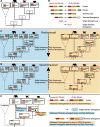The modular nature of protein evolution: domain rearrangement rates across eukaryotic life
- PMID: 32059645
- PMCID: PMC7023805
- DOI: 10.1186/s12862-020-1591-0
The modular nature of protein evolution: domain rearrangement rates across eukaryotic life
Abstract
Background: Modularity is important for evolutionary innovation. The recombination of existing units to form larger complexes with new functionalities spares the need to create novel elements from scratch. In proteins, this principle can be observed at the level of protein domains, functional subunits which are regularly rearranged to acquire new functions.
Results: In this study we analyse the mechanisms leading to new domain arrangements in five major eukaryotic clades (vertebrates, insects, fungi, monocots and eudicots) at unprecedented depth and breadth. This allows, for the first time, to directly compare rates of rearrangements between different clades and identify both lineage specific and general patterns of evolution in the context of domain rearrangements. We analyse arrangement changes along phylogenetic trees by reconstructing ancestral domain content in combination with feasible single step events, such as fusion or fission. Using this approach we explain up to 70% of all rearrangements by tracing them back to their precursors. We find that rates in general and the ratio between these rates for a given clade in particular, are highly consistent across all clades. In agreement with previous studies, fusions are the most frequent event leading to new domain arrangements. A lineage specific pattern in fungi reveals exceptionally high loss rates compared to other clades, supporting recent studies highlighting the importance of loss for evolutionary innovation. Furthermore, our methodology allows us to link domain emergences at specific nodes in the phylogenetic tree to important functional developments, such as the origin of hair in mammals.
Conclusions: Our results demonstrate that domain rearrangements are based on a canonical set of mutational events with rates which lie within a relatively narrow and consistent range. In addition, gained knowledge about these rates provides a basis for advanced domain-based methodologies for phylogenetics and homology analysis which complement current sequence-based methods.
Keywords: Ancestral reconstruction; Evolutionary history; Protein domain; Proteome analysis; Rearrangement rates.
Conflict of interest statement
The authors declare that they have no competing interests.
Figures



Similar articles
-
Tracing the paths of modular evolution by quantifying rearrangement events of protein domains.BMC Ecol Evol. 2025 Jan 8;25(1):6. doi: 10.1186/s12862-024-02347-7. BMC Ecol Evol. 2025. PMID: 39773110 Free PMC article.
-
Evolution of domain promiscuity in eukaryotic genomes--a perspective from the inferred ancestral domain architectures.Mol Biosyst. 2011 Mar;7(3):784-92. doi: 10.1039/c0mb00182a. Epub 2010 Dec 3. Mol Biosyst. 2011. PMID: 21127809 Free PMC article.
-
Dynamics and adaptive benefits of protein domain emergence and arrangements during plant genome evolution.Genome Biol Evol. 2012;4(3):316-29. doi: 10.1093/gbe/evs004. Epub 2012 Jan 16. Genome Biol Evol. 2012. PMID: 22250127 Free PMC article.
-
Quantification and functional analysis of modular protein evolution in a dense phylogenetic tree.Biochim Biophys Acta. 2013 May;1834(5):898-907. doi: 10.1016/j.bbapap.2013.01.007. Epub 2013 Feb 1. Biochim Biophys Acta. 2013. PMID: 23376183 Review.
-
Arrangements in the modular evolution of proteins.Trends Biochem Sci. 2008 Sep;33(9):444-51. doi: 10.1016/j.tibs.2008.05.008. Epub 2008 Jul 24. Trends Biochem Sci. 2008. PMID: 18656364 Review.
Cited by
-
Tracking of Ubiquitin Signaling through 3.5 Billion Years of Combinatorial Conjugation.Int J Mol Sci. 2024 Aug 8;25(16):8671. doi: 10.3390/ijms25168671. Int J Mol Sci. 2024. PMID: 39201358 Free PMC article. Review.
-
AARS Online: A collaborative database on the structure, function, and evolution of the aminoacyl-tRNA synthetases.IUBMB Life. 2024 Dec;76(12):1091-1105. doi: 10.1002/iub.2911. Epub 2024 Sep 9. IUBMB Life. 2024. PMID: 39247978 Free PMC article.
-
CANDy: Automated analysis of domain architectures in carbohydrate-active enzymes.PLoS One. 2024 Jul 11;19(7):e0306410. doi: 10.1371/journal.pone.0306410. eCollection 2024. PLoS One. 2024. PMID: 38990885 Free PMC article.
-
The structures of two archaeal type IV pili illuminate evolutionary relationships.Nat Commun. 2020 Jul 9;11(1):3424. doi: 10.1038/s41467-020-17268-4. Nat Commun. 2020. PMID: 32647180 Free PMC article.
-
Does Generic Cyclic Kinase Insert Domain of Receptor Tyrosine Kinase KIT Clone Its Native Homologue?Int J Mol Sci. 2022 Oct 25;23(21):12898. doi: 10.3390/ijms232112898. Int J Mol Sci. 2022. PMID: 36361689 Free PMC article.
References
-
- El-Gebali S, Mistry J, Bateman A, Eddy SR, Luciani A, Potter SC, Qureshi M, Richardson LJ, Salazar GA, Smart A, Sonnhammer ELL, Hirsh L, Paladin L, Piovesan D, Tosatto SCE, Finn RD. The Pfam protein families database in 2019. Nucleic Acids Res. 2019;47(D1):427–32. doi: 10.1093/nar/gky995. - DOI - PMC - PubMed
-
- Forslund K, Sonnhammer ELL. Evolution of protein domain architectures. In: Anisimova M, editor. Evolutionary Genomics: Statistical and Computational Methods, Volume 2. Totowa, NJ: Humana Press; 2012.
Publication types
MeSH terms
Substances
LinkOut - more resources
Full Text Sources

